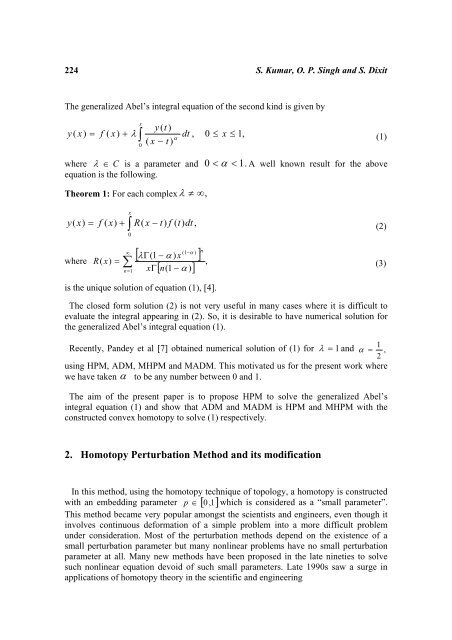An Analytic Algorithm for Generalized Abel Integral Equation
An Analytic Algorithm for Generalized Abel Integral Equation
An Analytic Algorithm for Generalized Abel Integral Equation
Create successful ePaper yourself
Turn your PDF publications into a flip-book with our unique Google optimized e-Paper software.
224 S. Kumar, O. P. Singh and S. Dixit<br />
The generalized <strong>Abel</strong>’s integral equation of the second kind is given by<br />
x<br />
y ( t )<br />
y ( x)<br />
= f ( x)<br />
+ λ ∫ dt , 0 ≤ x ≤ 1,<br />
α<br />
(1)<br />
( x − t )<br />
0<br />
where λ ∈ C is a parameter and 0 < α < 1.<br />
A well known result <strong>for</strong> the above<br />
equation is the following.<br />
Theorem 1: For each complex λ ≠ ∞,<br />
x<br />
y(<br />
x)<br />
= f ( x)<br />
+ ∫ R(<br />
x − t)<br />
f ( t)<br />
dt ,<br />
(2)<br />
0<br />
( 1−α<br />
)<br />
[ λΓ<br />
( 1 − α ) x ]<br />
where<br />
R(<br />
x)<br />
∑<br />
1<br />
∞<br />
=<br />
n=<br />
xΓ<br />
[ n(<br />
1 − α ) ]<br />
is the unique solution of equation (1), [4].<br />
n<br />
,<br />
The closed <strong>for</strong>m solution (2) is not very useful in many cases where it is difficult to<br />
evaluate the integral appearing in (2). So, it is desirable to have numerical solution <strong>for</strong><br />
the generalized <strong>Abel</strong>’s integral equation (1).<br />
Recently, Pandey et al [7] obtained numerical solution of (1) <strong>for</strong> λ = 1 and<br />
1<br />
α = ,<br />
using HPM, ADM, MHPM and MADM. This motivated us <strong>for</strong> the present work where<br />
we have taken α to be any number between 0 and 1.<br />
The aim of the present paper is to propose HPM to solve the generalized <strong>Abel</strong>’s<br />
integral equation (1) and show that ADM and MADM is HPM and MHPM with the<br />
constructed convex homotopy to solve (1) respectively.<br />
2. Homotopy Perturbation Method and its modification<br />
In this method, using the homotopy technique of topology, a homotopy is constructed<br />
with an embedding parameter p ∈ [ 0 , 1]<br />
which is considered as a “small parameter”.<br />
This method became very popular amongst the scientists and engineers, even though it<br />
involves continuous de<strong>for</strong>mation of a simple problem into a more difficult problem<br />
under consideration. Most of the perturbation methods depend on the existence of a<br />
small perturbation parameter but many nonlinear problems have no small perturbation<br />
parameter at all. Many new methods have been proposed in the late nineties to solve<br />
such nonlinear equation devoid of such small parameters. Late 1990s saw a surge in<br />
applications of homotopy theory in the scientific and engineering<br />
(3)<br />
2

















